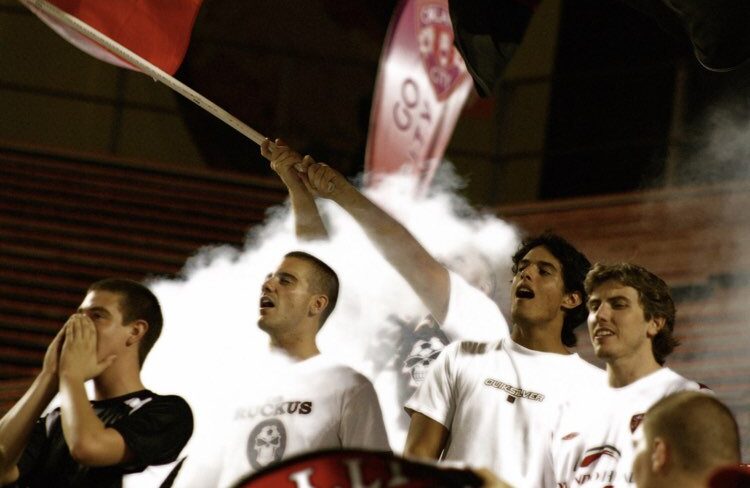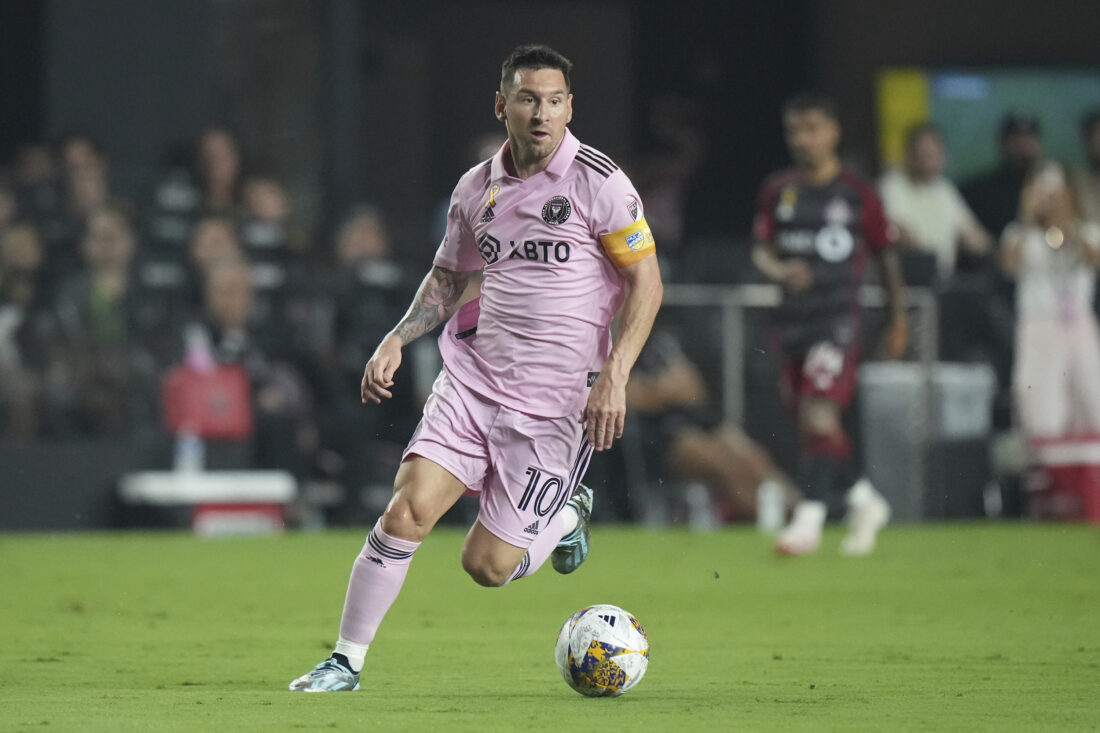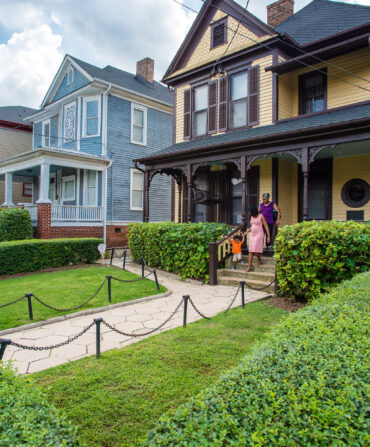A pizza confirmed that Lionel Messi wouldn’t be coming to Atlanta. Georgia soccer fans had waited breathlessly to see whether the world’s greatest player would join his Inter Miami team in their much-hyped match against Atlanta United on September 16. But Messi had stayed home, posting an Instagram video of a pizza delivery to prove it. The disappointment, it turned out, was short-lived: Over seventy thousand spectators packed Mercedes-Benz stadium even without the missing G.O.A.T. Taunts of “Where is Messi?” could be heard reverberating through the arena, and the crowd roared with enthusiasm as Atlanta United beat Inter Miami 5–2.
Home team fans had plenty of reasons to cheer. The day before, the U.S. Soccer Federation had announced it was relocating its training center and company headquarters to Atlanta. And Atlanta United FC, the city’s Major League Soccer expansion team that won the MLS Cup in only its second year of existence, had bounced back from a mid-season slump and was well on its way to qualifying for the 2023 Cup playoffs (now in its first round).
But Atlanta soccer fans weren’t the only ones celebrating. The sport has made huge strides in the United States, growing in popularity and adding professional teams at a rapid clip in both the men’s and women’s leagues. The South has been a big driver of that enthusiasm: Of the eighteen teams that qualified for the MLS playoffs this year, six are from Southern cities. Messi’s arrival in Florida has drawn a flurry of international attention to American soccer and put the spotlight on Inter Miami’s rivalries with other Southeastern teams. Ahead of the 2026 World Cup, FIFA announced that stadiums in four Southern states will help to host the tournament; some of those same stadiums will likely welcome Copa America in 2024. As the arrival of both U.S. Soccer and major world tournaments makes clear, the South has the infrastructure, investment, and enthusiasm to keep the beautiful game growing for years to come.
As the 2023 MLS season wraps up, we look back on this year’s major soccer developments and how they’re shifting the sport down South.
Messi mania in Miami (and beyond)
It’s not uncommon for European soccer stars to take a victory lap in the American MLS before retiring; David Beckham and Zlatan Ibrahimović did it at LA Galaxy, Kaká at Orlando City, and Henry Thierry at New York Red Bulls, to name a few. But none of them caused anything close to the international sensation that was Lionel Messi’s signing with Inter Miami. Subscriptions to Apple TV’s MLS Season Pass doubled in the wake of his arrival, with a 1,690 percent spike in sign-ups alone on the day he played his first game. Wherever he plays, game attendance skyrockets, and his bubblegum-pink Inter Miami jersey routinely sells out so fast, even club owner David Beckham was told he’d have to wait for one.

“Along with Tiger Woods and probably Michael Jordan, he’s one of the three most identifiable athletes even to non-sports fans around the world,” Doug Robertson, a sports journalist who covers soccer for the Atlanta Journal-Constitution, explains. “That’s different, and it’s brought more international attention to the MLS league.”
Messi, the eight-time Ballon d’Or winner and World Cup champion who had a legendary career with Barcelona and played briefly with Paris Saint-Germain before coming to the MLS, has been a literal game changer for Inter Miami. Along with his former Barcelona teammates Sergio Busquets and Jordi Alba, who joined the team (and their friend) at the same time, Messi helped Inter Miami clinch the Leagues Cup last July. The trio arrived too late in the season to nudge the team into the MLS playoffs, but Messi’s formidable scoring spree in only six games has Miami fans giddy about next season’s potential.
The international hubbub around the Argentine phenom has put the spotlight not just on Inter Miami, but on its competitors in the MLS. “New fan here,” a user posted in the Inter Miami Reddit group immediately after Messi signed with the club. “Who do we hate?”
Not everyone is equally dazzled by the Messi effect. “Most of us in Orlando are just bored with the whole Messi-Miami phenomenon. We loved soccer long before the Argentinian star graced our state with all his awesomeness,” Dan Conlee quips. Conlee and his wife Lori founded Ruckus, the original supporter’s group for Orlando City, which is Inter Miami’s primary rival. But he acknowledges that Messi Mania has brought attention to Florida soccer in a new way—and united Orlando City fans in their enmity for Inter Miami. “We were absolutely ecstatic when they were shut off and had no way of making the playoffs,” he says with a laugh.
U.S. soccer pulls a snowbird
The national soccer federation had many good reasons to move to Atlanta, but mild winters were high on the list. “You can play [outside] year-round in Georgia,” the AJC’s Robertson says, “compared to Chicago or Kansas City, where they also have training centers.”
Atlanta’s East Coast location and its busy Hartsfield-Jackson International Airport were also draws, making it easier for Americans playing across the Atlantic to fly home for national team training. And $50 million from Arthur Blank, CEO of Home Depot and owner of both Atlanta United and the Atlanta Falcons NFL team, didn’t hurt either.
The U.S. Soccer Federation, the official governing body of American soccer, oversees twenty-seven youth and adult teams, including the U.S. men’s and women’s national teams. The move will bring the federation’s headquarters to Atlanta along with a national training center that will host all twenty-seven teams, youth tournaments, soccer conferences, and soccer-related community outreach. Blank’s contribution will help build facilities for the federation’s extended national teams, which include teams for players with cerebral palsy and deaf athletes, as well as programs focused on growing the sport in the U.S. and youth development in underserved communities.
Developing young American talent is key to growing the game nationally. When asked why the U.S. Men’s National Team fares so poorly in world competition, soccer experts often point to the American youth soccer model, which relies more on pay-to-play club teams than investment in development from the national federation and from professional clubs, both of which are more common in soccer-dominant Europe and South America. The MLS’s training academies have helped bridge the gap of late, launching the careers of homegrown talent like Atlanta United’s Caleb Wiley and Dallas FC’s Jesús Ferreira.
Conversely, American investment in girls’ sports, especially relative to other countries, has made the U.S. Women’s National Team the best in the world—but as other nations take the hint on developing young female talent, the field is becoming much more competitive. And while MLS has grown rapidly throughout the South, the women’s professional league, NWSL, has not had the same reach in the region, so there’s more work to be done.
For many national team players, the federation’s move isn’t just a smart business decision—it’s a homecoming. “It’s great for the future of the game in the USA, and Atlanta is of course near and dear to my heart,” Kelley O’Hara, a veteran U.S. Women’s National Team defender who grew up in Fayetteville, Georgia, said in a statement. “The city will be a wonderful host, and I can’t think of a better location.”
The rise of Southern soccer fan culture
Dan and Lori Conlee, who founded Ruckus, the Orlando City supporters group, used to have to travel abroad to get their soccer fan fix. “We took football vacations to see Liverpool or Manchester play in the Premier League,” Dan says. “So when we heard a little crackle on the internet about a pro team in Orlando, we were so excited.”
Orlando City SC launched in 2010 in the second-tier United Soccer League, then moved up to the MLS in 2015. The MLS Cup has evaded Orlando so far, but with a number-two ranking in the Eastern Conference, they’re closer to the championship than ever before. Orlando City’s fans are known for their enthusiasm, joining forces at matches to create “the Wall.” At its peak, Ruckus had over 1,700 members, though turnout has slowed post-pandemic. The Conlees launched their supporters group the day the club was announced and grew it from scratch alongside the team. “They call me the Godfather,” Dan Conlee says with a laugh. “I don’t think half the people in the group know my real name.”
When Major League Soccer launched in 1996, only two of the original ten teams were located in the South. Now there’s eight (of twenty-nine total), four of which have been added just since 2020. “The sport is growing in the South,” the AJC’s Robertson says. “Now it needs time to mature. The franchise needs time to grow and strengthen their fan bases.”
It’s not easy to cultivate a fan base around a new team, but Southern MLS teams have been surprisingly successful: This year, Atlanta United recorded the highest average attendance record, followed by Charlotte FC, an expansion team that launched two years ago.
Demographic trends may be on their side. Most of the country’s fastest-growing cities are in the South, and major Sunbelt metro areas like Nashville, Orlando, and Atlanta are booming, drawing millions of new arrivals, many of whom are eager to join a new fan base. And as Southern cities diversify, families immigrating from soccer-crazed countries are bringing that enthusiasm with them. A Telemundo report found Latinos drove a 52 percent growth in U.S. soccer fans between 2012 and 2019.
MLS has assiduously cultivated that fan base to strengthen its roots across the country. Many franchises have Latino-focused supporter groups, like Orlando City’s Iron Lion Firm, which forms “the Wall” with Ruckus at every match. Spanish-language chants can be heard at MLS matches across the country, and many clubs create merchandise and programming around Latino pride and heritage. “We view the Hispanic market as part of our DNA,” Gabriel Gabor, an MLS international communications consultant, told The Guardian in 2016. “It’s part of how we function and everything we do.” And with 33.4 percent of players reporting being Latino (which includes Brazilians), MLS is a bicultural league both off the pitch and on it.
All told, soccer’s come a long way in the U.S., but don’t expect the sport to dominate here like it does in the United Kingdom or Argentina, at least any time soon. A 2023 Washington Post poll found 8 percent of Americans listed soccer as their favorite sport, up from 2 percent in 2004. That’s close to the numbers for baseball (9 percent) and basketball (12 percent) but still a far cry from American football, the fan favorite for 34 percent of Americans.
“Is soccer ever going to rival football in North America? No.” Robertson acknowledges. ”But people have to be patient; the MLS is only twenty-seven years old. There’s definitely room to grow.”
Like many Southern soccer fans, Dan and Lori Conlee also follow American football. But part of what keeps them hooked on soccer, they say, is the fan culture—the passionate energy that supporters bring every match day, which has been a key element of the sport since it began filling stadiums over three thousand years ago.
“The fans can change the game more in soccer than in any other sport,” Lori says. “The singing, the drumming, all the instruments—everything that we’re doing to generate the atmosphere, that’s unique in American sports for sure.”








